The Samsung Galaxy S7 and S7 edge Review: Part 2
by Joshua Ho on July 5, 2016 8:00 AM ESTSystem Performance Cont'd
Now that we've gone over the more general purpose system benchmarks we can focus on new benchmarks that emphasize GPU performance much more strongly. For the most part we haven't had huge issues here like we've had with good CPU and general performance benchmarks, but it's important for us to keep our benchmarks up to date in terms of workload balance and overall performance.
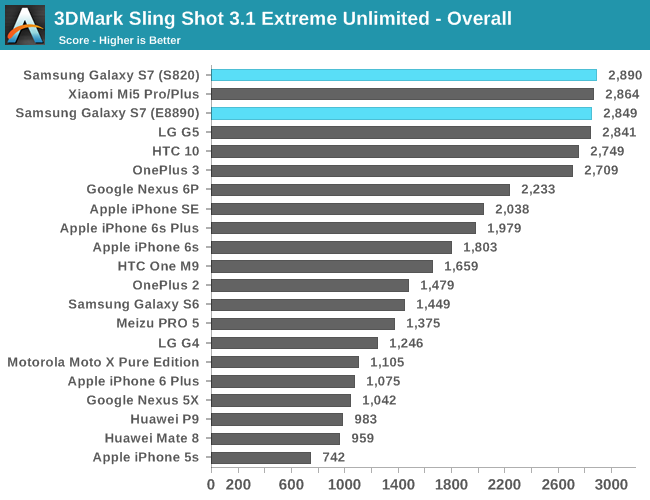
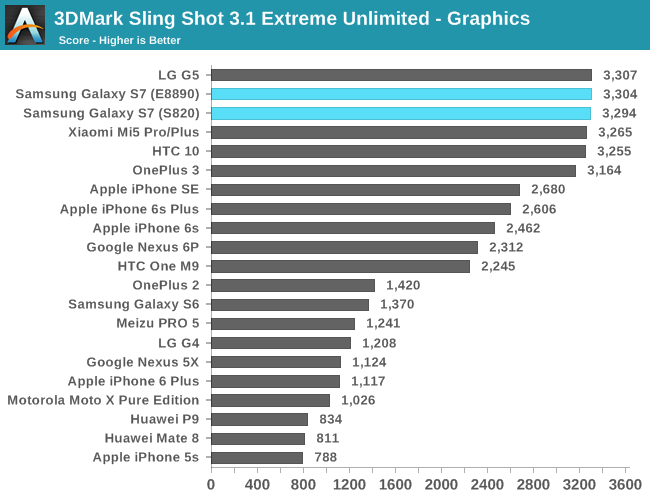
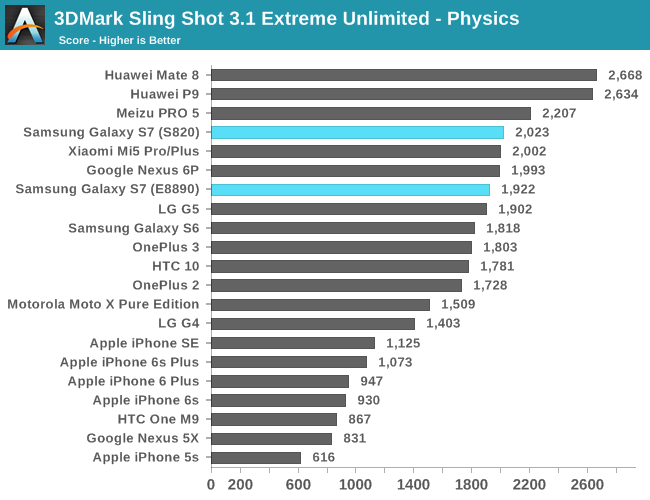
One of our first new benchmarks designed to better test the GPU is 3DMark's Sling Shot ES 3.1 test, which is designed to test a GPU's performance when the application is either using OpenGL ES 3.1 or Metal. As one can see, the Snapdragon 820 and Exynos 8890 have basically comparable GPU performance in this test and in the physics test as well. Once again we're seeing how core count and clock speed are basically the primary determinants of performance in the physics test when the device isn't strongly limited by thermals. I wouldn't draw any real conclusions from this as generally game CPU code can extract ILP unlike what we're seeing in this test.


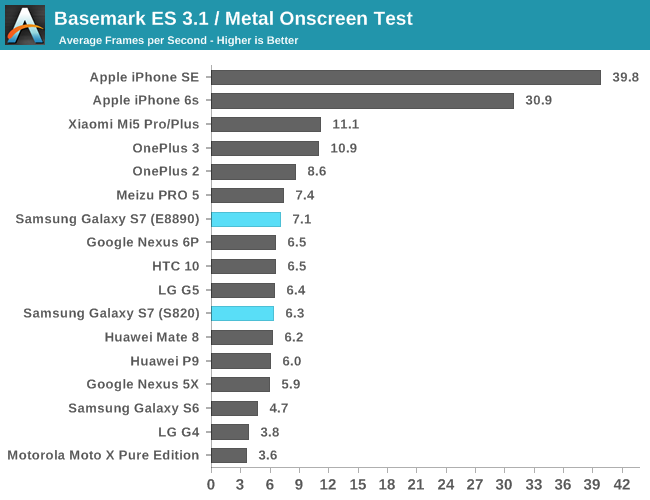
In this test we start to see that the Mali GPU in the Exynos 8890 and the PowerVR GPU in the A9 are providing a noticeable advantage over the Snapdragon 820's Adreno 530 to a noticeable extent.

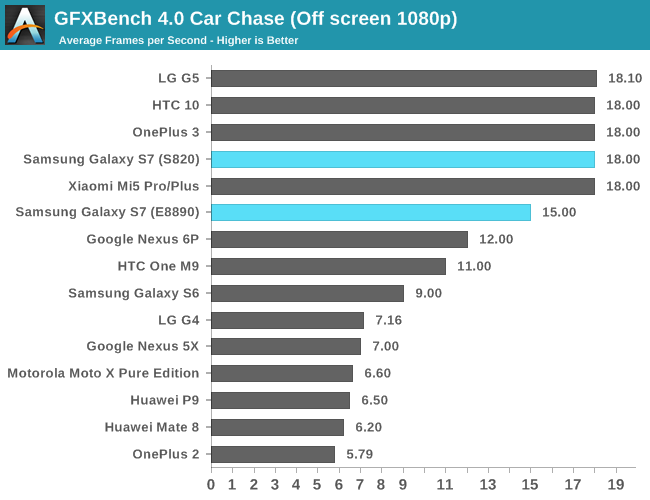
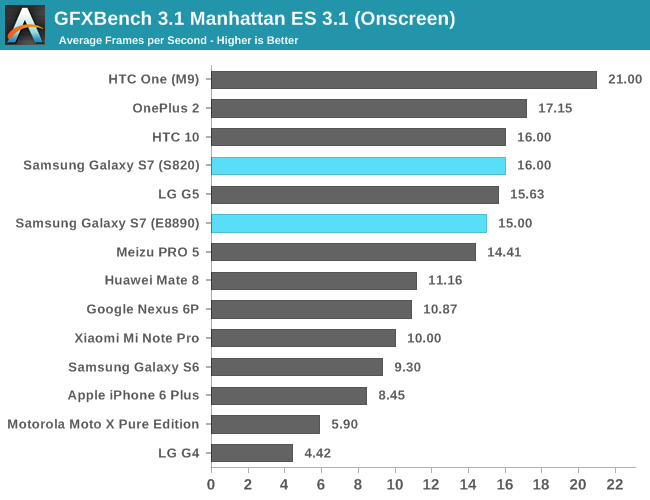
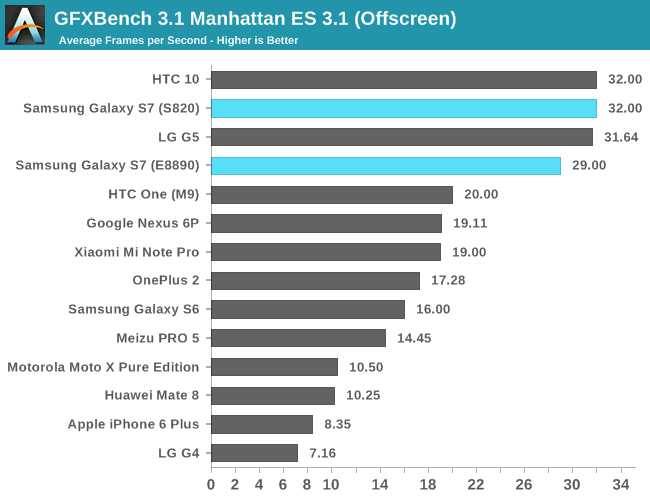
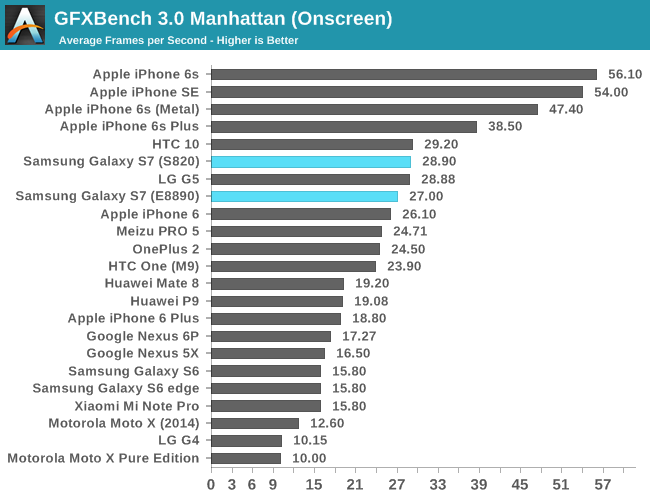
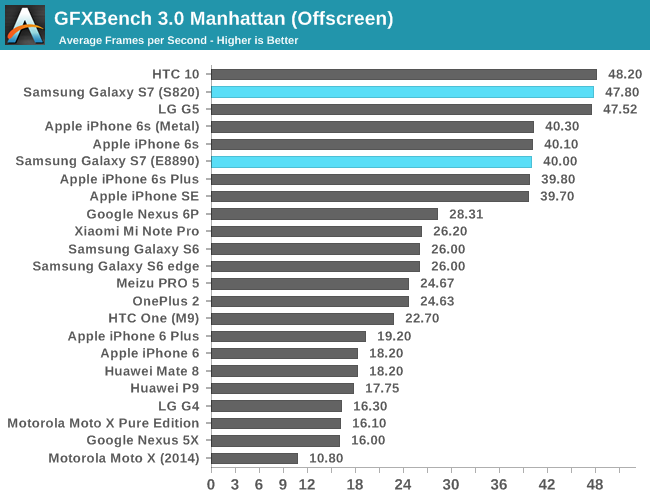
With GFXBench we can see that in Car Chase and Manhattan the Adreno 530 actually manages to pull away. However, because we have basically zero architecture disclosure on the Adreno 530 there's really no way for us to explain what's going on here and why. The reasons for the difference in performance could be related to drivers or architecture or architecture implementation and in the absence of information it's probably best to avoid making blind guesses. Regardless of these details, the Snapdragon 820's GPU should be more than enough for playing the latest games, but unless you use Samsung's automatic game optimizer system to set render resolution to 1080p it won't do as well as the iPhone 6s but given that most Android games target a much lower spec level it's likely that you won't have any problems given that the Adreno 530 is on the bleeding edge for Android SoCs.










266 Comments
View All Comments
Impulses - Thursday, July 7, 2016 - link
Eh... It's not like Samsung's focusing makes it a particularly great camera for shooting hardcore action (no smartphone within the current climate is gonna manage that)...So I'd actually argue that AF doesn't really take such top billing, in fact depending on what you're shooting it can be somewhat irrelevant. On a technical level it's super interesting tho.
The fact that they've got a dual pixel arrangement working at such a high level almost makes it puzzling that they haven't implemented it on a larger sensor and never tried carrying it over to their now dead camera division.
lilmoe - Thursday, July 7, 2016 - link
Yea, fanboys would have an argument like yours too... Tim Cook knows exactly how important the autofocus system is.Impulses - Thursday, July 7, 2016 - link
Not sure what brand I'm supposed to be a fan boy of, heh... I've never bought neither a Samsung nor an Apple phone, and probably never will unless Samsung drastically changes their software strategy or GPe comes back.My point was coming from a snobbish "I wouldn't use a phone for THAT" (vs a dedicated camera) pov. ;)
lilmoe - Friday, July 8, 2016 - link
Snob... Fanboy... All the same.Case in point, you don't need to be shooting fast action to realize the benefits of great autofocus. If you're taking pictures of your kids or buddies on a trip, then it means either getting the shot or not. If it's blurry, then all that snobby pixel peeping won't help you much.
FourEyedGeek - Saturday, July 9, 2016 - link
Judgemental dickwad.johnnohj - Tuesday, July 5, 2016 - link
Exactly, how much better was the performance on the browser benchmarks with the Snapdragon browser or the Samsung stock browser? Why didn't you include them?ikjadoon - Tuesday, July 5, 2016 - link
Snapdragon Browsers are great; I use one on my OPO and it's a huge boost in scrolling, page loading, and overall speed. Using Chrome vs Tugabrowser on my OPO is like using Firefox vs Chrome on my PC. It's not even close.But, they don't ship with the device. It's a 3rd-party app you have to download onto your phone.
--
Samsung Browser...yeah, no idea why they didn't include that. That should've been in there. They test Safari on iPhones, why not test SB on Samsung phones?
kurahk7 - Tuesday, July 5, 2016 - link
Samsung sent everyone Verizon versions which until a couple months ago didn't support the Samsung browser. But since this review was so late, they should have included it and talked about the functionality of it.JoshHo - Tuesday, July 5, 2016 - link
I tried shortly after the Samsung stock browser was made available and a number of our benchmarks wouldn't complete or performed worse than Chrome so I didn't include those results.asfletch - Tuesday, July 5, 2016 - link
Hmm that is odd. On my Note 4 Exynos, the Samsung Browser runs Jetstream, Vellamo, Kraken et al just fine, and way faster than Chrome (esp now Adblock Plus is officially available for it - so good). Feels far faster in use too, as mentioned in this review. Maybe it's the SD820 - could Andrei test the 8890 version with Samsung Browser please?